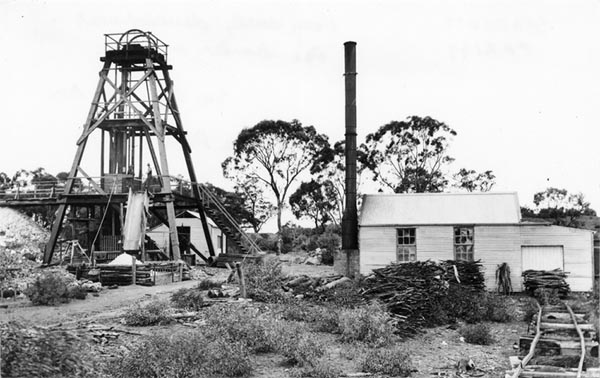Diamond Creek today has no visible signs that it was once a busy gold mining township with two major mines on the hill behind our new Op Shop, locally known as “Mine Hill”.
Gold was discovered at Diamond Creek in the early 1860’s leading to a tunnel on the south side of “Mine Hill”, at the end of Dering Street, which was mined using a king-sized skip truck.
By 1870 the tunnel mine was the “Union” goldmine, a major operation with a shaft, steam powered winder and battery. The engine house was a rustic wooden building with shingle roof. The head frame was also made of wood with a bush ladder up one leg to reach the deck. At this time rope cables were used on the Victorian goldfields to haul up skips of ore, mullock and miners. Before wire cables were introduced there were many accidents due to worn and dodgy rope cables.
The Union gold ran out in 1875. Exploration in 1904 revealed further good ore could be accessed with a new shaft further to the east using a winder with safer wire cables. Reaching eight levels the Union finally closed down in 1908. All machinery was removed.
The boiler was trucked around to the “Diamond Creek Goldmine” on top of Mine Hill. The foundations of the Union winder were left to be overgrown and guarded by red bellied black snakes.
By 1915 the Diamond Creek Goldmine, on top of mine hill, had grown to a much bigger mine than the Union. Its big engine house contained five boilers, powering the winder, battery, generator, air compressors and a massive beam water pump. This pump ran constantly to keep the mine dry. [In early 1915 a fire broke out.]
Some of the miners who had worked at the neighbouring Union Mine took a shortcut and found their way to the old Union workings through connecting tunnels and walked out to the Union site.
They then walked around to the Diamond Creek mine ruins to wait for their mates. No lives were lost and the mine shut down. In the early 1950’s the mine re-opened with an electrical winder and head frame. Oblong buckets were fitted to the cables and water was bailed out. One up, one down, the 1000 foot shaft and tunnels were flooded to about 350 feet. The mine was pumped dry for inspection but progress stopped. The water came back and the head frame and winder removed.
In the early 1950’s the mine re-opened with an electrical winder and head frame. Oblong buckets were fitted to the cables and water was bailed out. One up, one down, the 1000 foot shaft and tunnels were flooded to about 350 feet. The mine was pumped dry for inspection but progress stopped. The water came back and the head frame and winder removed. Shareholders left with worthless certificates.
by Kevin Patterson, Diamond Creek News Autumn 2013 p. 3
Photo: Diamond Creek Main Shaft after fire 1915 Nillumbik Local History Digitisation Project Nillumbik Historical Society in partnership with Yarra Plenty Regional Library. (PP2172)

This was quite a rich goldfield in its day.